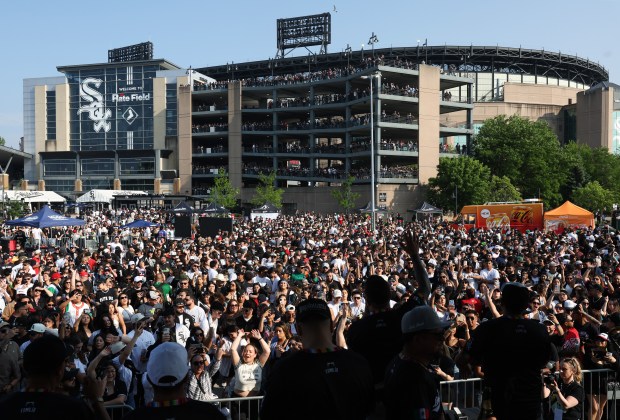Mayor Brandon Johnson is asking businesses to offer up new violent crime response tools just as his administration ends the ShotSpotter police technology deal, and the controversial outgoing vendor intends to throw its hat in the ring to continue operating in Chicago.
Johnson issued a request for information about technologies that “ensure quick response by law enforcement authorities in emergency situations” Sunday afternoon, hours before the ShotSpotter acoustic gunshot detection system went offline at midnight. The move launches a typically months-long procurement process.
But what tools that process will ultimately give first responders is so far unclear. The city hopes the request will garner interest from a wide range of new technologies, Deputy Mayor for Community Safety Garien Gatewood told the Tribune Monday
“Crime is still and will forever be the number one issue,” Gatewood said. “We need to see what options are out there.”
A ShotSpotter representative said Monday the company behind the tool, SoundThinking, plans to respond to the request in a bid to get a new deal after Johnson dumped them in a process marked by the mayor deriding the system as “walkie-talkies on a pole.”
Johnson first described the plan to acquire new first responder technology at a Wednesday news conference. When asked why his administration had not made the request earlier — seven months have passed since the mayor announced in February he would decommission ShotSpotter — Johnson argued ShotSpotter was not sufficiently vetted when it was first brought to the city.
“Some things take time when you are doing it right,” he said. “A reasonable timeline is to do it right. It’s to do it right. I’m going to do it right.”
The city’s request for information solicits a technology similar to how ShotSpotter describes itself. The new tools should detect, vet and report “incidents” to police with positional data within 60 seconds, the request says. ShotSpotter uses acoustic sensors mounted on light poles, mostly on the South and West sides, to quickly alert police about the location of suspected gunfire, though critics, including the mayor, doubt its accuracy.
Companies will be able to respond to the city’s request for six weeks, Gatewood said. The city will likely then create a request for more specific proposals that could lead to a contract. That whole process will take time, Gatewood acknowledged.
“We want to be intentional about it. I think it’s also important that we make sure multiple constituencies are heard, because this is a hot button issue,” Gatewood said.
The working group requesting and weighing the new technologies includes members from law enforcement, violence prevention groups and elected police district councils, Gatewood said. While the group first met in August, some members had started discussing new technology earlier, he added.
The request follows months of furious debate in the City Council over the future of ShotSpotter. Most aldermen have sharply rebuffed Johnson’s criticism of the tool as inaccurate and too expensive. Neighborhoods facing violence need the tool to help get gunshot victims medical aid fast, they argue.
Aldermen voted with a veto-proof majority in May to give themselves control over ShotSpotter’s future, then again in a 33-14 vote Wednesday to shift that control to police Superintendent Larry Snelling, who previously praised the tool.
But Johnson’s administration says the votes are moot: Only the mayor has power over city contracts, meaning the ordinances have no legal weight, they argue.
After the Wednesday vote, Johnson said he planned to issue a rare veto to overturn the City Council’s decision, but had yet to do so Monday morning.
As their standoff with the unyielding mayor continues, aggrieved aldermen in support of ShotSpotter are sharply ramping up their rhetoric, increasingly pinning blame on him for gunshot deaths.
“Starting tonight, every gunshot victim left bleeding in the streets of our city will be a worthy sacrifice in the eyes of the mayor for his radical agenda,” Ald. Silvana Tabares, 23rd, wrote in an X post Sunday.
But the Chicago Police Department struck a far less antagonistic tone, calling the change “no different” from others protocol shifts in a statement Sunday.
“This does not change our commitment to public safety and building stronger neighborhoods for all of our residents. Our hardworking officers will continue to respond to crime and work to stop the trauma of violence plaguing our communities,” the department wrote.
Gatewood said ShotSpotter is neither the “end-all be-all,” nor a “driving force” in this year’s citywide decrease in violence crime. Murders are down 9% and shootings have dropped 6% through mid-September, according to CPD data.
“The Chicago Police Department does not rely on one piece of technology to do the work that they do, and having one piece of technology won’t be the reason that CPD and this administration continue to drive crime down,” he said.
Instead, the deputy mayor argued, the administration and Police Department’s more gradual work to build safety should get the credit. Gatewood touted better interdepartmental communication, investments in tools like three new helicopters and a careful “block-by-block” approach to build trust in police in neighborhoods.
Efforts to work more closely with violence intervention groups and work more visibly on blocks hit hard by recent violence have paid off, he said. He credited the Johnson’s strategy with driving down the often chaotic so-called “teen trend” events where young people have gathered en masse.
“We will work with anybody who wants to show up and work for the people of the city of Chicago. Anybody,” Gatewood said.
jsheridan@chicagotribune.com



